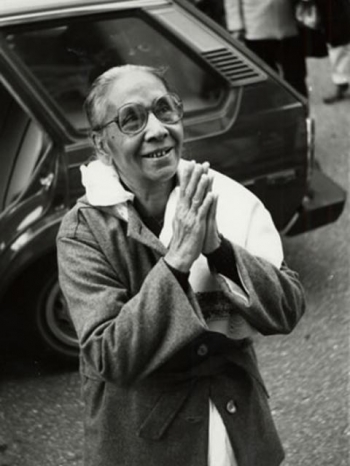Biography of Dipa Ma – 1911-1989
 Gotama Buddha’s familiar story follows the archetypal hero’s journey: he left behind wife and child and renounced the ordinary world to seek the holy life. Dipa Ma followed a similar path, but with an unexpected turn. Ultimately she took her practice home again, living out her enlightenment in a simple city apartment with her daughter. Her responsibilities as a parent were clarified by her spiritual practice; she made decisions based not on guilt and obligation but on the wisdom and compassion that arose from meditation.
Gotama Buddha’s familiar story follows the archetypal hero’s journey: he left behind wife and child and renounced the ordinary world to seek the holy life. Dipa Ma followed a similar path, but with an unexpected turn. Ultimately she took her practice home again, living out her enlightenment in a simple city apartment with her daughter. Her responsibilities as a parent were clarified by her spiritual practice; she made decisions based not on guilt and obligation but on the wisdom and compassion that arose from meditation.
Nani Bala Barua, later known as Dipa Ma, was born in 1911 in a village on the plains of Chittagong in what is now Bangladesh. The indigenous Buddhist culture there traces its lineage in an unbroken line back to the Buddha. By the time Dipa Ma was born, meditation practice had almost disappeared among her clan, but they continued to observe Buddhist rituals and customs.
Though intensely interested in Buddhism from a young age, like most Asian women of her era Dipa Ma had little opportunity to undertake serious spiritual training.
Dipa Ma’s early life followed the expected path of a village girl in East Bengal. At age twelve, she married Rajani Ranjan Barua, an engineer twice her age, who left one week after their wedding to take a job in Burma. After two lonely years in her in-laws’ home, she was sent to Rangoon to join her husband. To the couple’s great disappointment, the young Dipa Ma was unable to become pregnant and to add to this difficulty, her mother died while she was still adjusting to her new life. Although she was eventually able to bear children, she lost two as infants and then fell seriously ill herself. Through it all, Rajani was patient, loving, and wise. The couple adopted her much younger brother, Bijoy
Dipa Ma raised her younger brother, gave birth to Dipa, and looked after her husband. But for several years she was confined to her bed with heart disease and hypertension, scarcely able to care for herself and her young daughter. In her mid-forties, after Bijoy had grown up and left home, Rajani died suddenly, leaving Dipa Ma devastated. She believed she would soon die if she did not find a way to free herself from her burden of grief. She resolved to learn meditation, convinced it was the only way she could save herself. Soon after, she dreamed of the Buddha softly chanting these verses from the Dhammapada:
Piyato Jayati Soko ,
piyato jayati bhayam
piyato vippamuttassa,
Natthi Soko Kuto Bhayam.
Clinging to what is dear brings sorrow.
Clinging to what is dear brings fear.
To one who is entirely free from endearment
There is no sorrow or fear.
Awakening from the dream, Dipa Ma felt a calm determination to devote herself fully to meditation practice. She arranged to go to the Kamayut Meditation Center in Rangoon.
Early in the morning during her first day at the center, Dipa Ma was given a room and basic instructions and told to report to the meditation hall late that afternoon. As she sat in meditation through the day, her concentration rapidly deepened. Later, on her way to the meditation hall, she suddenly found herself unable to move. For several minutes, she couldn’t even lift a foot, which puzzled her. Finally she realized that a dog had clamped its teeth around her leg and wouldn’t let go. Amazingly, her concentration had become so deep even in those first few hours of practice that she had felt no pain. Eventually, the dog was pulled away by some monks. Dipa Ma went to a hospital for rabies injections and then returned home to recuperate.Once home, her distraught daughter would not allow her to leave again. With her characteristic practicality and resourcefulness, Dipa Ma recognized that her spiritual journey would have to take a different form. Using the instructions given at her short retreat, she patiently meditated at home, committing herself to the diligent practice of awareness, moment by moment.
After several years, Munindra, a family friend who lived nearby, encouraged Dipa Ma, then fifty-three years old, to come to the meditation center where he was studying under the renowned teacher Mahasi Sayadaw. After only few days of practice, she reached the first stage of enligtenment.
For the rest of the year, Dipa Ma went back and forth between home and the meditation center, where she rapidly progressed through further stages of enlightenment. (As described in the Visuddhimagga, the Theravada tradition recognizes four such stages, each producing distinct, recognizable changes in the mind.) People who knew her were fascinated by her change from a sickly, grief-stricken woman to a calm, strong, healthy, radiant being.
Inspired by this transformation, Dipa Ma’s friends and family including her daughter, joined her at the meditation center. One of the first to arrive was Dipa Ma’s sister, Hema. Although Hema had eight children, with five still living at home, she managed to make time to practice with her sister for almost a year. She also reached a first stage of enlightenment as well as her daughter Dipa.
In 1967, the Burmese government ordered all foreign nationals to leave the country. Dipa Ma decided to go to Calcutta with her daughter. Their new living conditions were modest, even by Calcutta standards. They had no running water, their stove was a charcoal burner on the floor, and they shared a toilet with another family. Soon word spread in Calcutta that an accomplished meditation teacher had come from Burma. Women trying to fit spiritual training in between the endless demands of managing their households appeared at Dipa Ma’s apartment during the day, seeking instruction. She obliged by offering individualized teaching tailored to full lives—but with no concessions to busyness.
Dipa Ma’s path wasn’t attached to a particular place, teacher, lifestyle, or the monastic model. The world was her monastery; mothering and teaching were her practice. She embraced family and meditation as one, in a heart that steadfastly refused to make divisions in life.
“She told me, ‘Being a wife, being a mother—these were my first teachers,’” recalls Sharon Kreider, a mother who studied with Dipa Ma. “She taught me that whatever we do, whether one is a teacher, a wife, a mother—they are all noble. They are all equal.”
For Dipa Ma there was simply the practice of being present, being fully awake, all the time, in every situation; she was a living demonstration that the real nature of mind is presence.
Source Dipama.com
